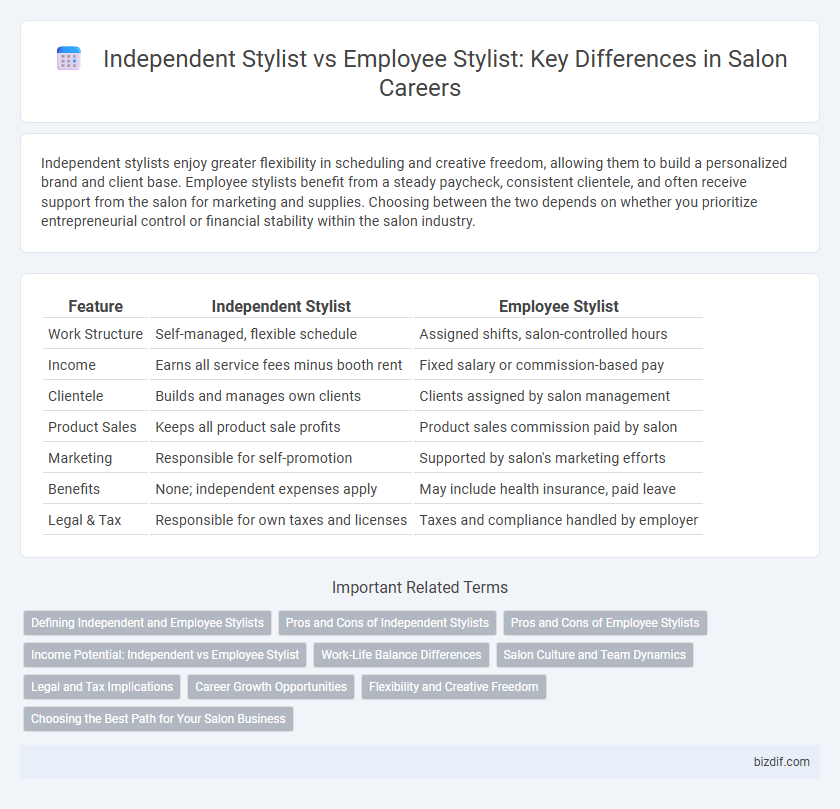Independent stylists enjoy greater flexibility in scheduling and creative freedom, allowing them to build a personalized brand and client base. Employee stylists benefit from a steady paycheck, consistent clientele, and often receive support from the salon for marketing and supplies. Choosing between the two depends on whether you prioritize entrepreneurial control or financial stability within the salon industry.
Table of Comparison
| Feature | Independent Stylist | Employee Stylist |
|---|---|---|
| Work Structure | Self-managed, flexible schedule | Assigned shifts, salon-controlled hours |
| Income | Earns all service fees minus booth rent | Fixed salary or commission-based pay |
| Clientele | Builds and manages own clients | Clients assigned by salon management |
| Product Sales | Keeps all product sale profits | Product sales commission paid by salon |
| Marketing | Responsible for self-promotion | Supported by salon's marketing efforts |
| Benefits | None; independent expenses apply | May include health insurance, paid leave |
| Legal & Tax | Responsible for own taxes and licenses | Taxes and compliance handled by employer |
Defining Independent and Employee Stylists
Independent stylists operate their own businesses within or outside a salon, managing clients, schedules, and finances independently, while employee stylists work under salon management with set hours, receiving wages or commissions. Independent stylists often cover their own expenses including booth rent, supplies, and marketing, contrasting with employee stylists who typically have resources provided by the salon. Understanding these roles is essential for both stylists and clients to align expectations on service flexibility, pricing, and professional responsibilities.
Pros and Cons of Independent Stylists
Independent stylists enjoy flexible schedules and higher earning potential by setting their own rates, allowing for greater control over their career growth. However, they bear the responsibility of managing business expenses such as rent, supplies, and marketing, which can impact profitability. The lack of a steady paycheck and benefits like health insurance or paid time off presents challenges that require strong self-discipline and financial planning.
Pros and Cons of Employee Stylists
Employee stylists benefit from a steady income and access to salon resources such as marketing, clients, and products, reducing the burden of self-promotion and business management. However, they face limitations in creative control and may have to adhere to salon policies, schedules, and commission splits that impact their overall earnings. Dependence on the salon's brand reputation can provide client trust but also restricts their ability to build a personalized brand independently.
Income Potential: Independent vs Employee Stylist
Independent stylists typically have higher income potential since they retain a larger percentage of their earnings and can set their own prices, while employee stylists earn a fixed hourly wage or commission, limiting their overall revenue. Independent stylists also benefit from tax deductions and multiple revenue streams through product sales and service upselling, whereas employee stylists rely mainly on their schedule and salon policies. The trade-off includes greater financial risk for independents but increased financial stability for employees with consistent paychecks.
Work-Life Balance Differences
Independent stylists enjoy greater flexibility in setting their own schedules, allowing for a more personalized work-life balance tailored to individual needs. Employee stylists often work fixed hours dictated by salon management, which can limit their ability to manage personal commitments outside of work. The autonomy of independent stylists typically results in better control over workload and time off, contributing to improved overall work-life integration.
Salon Culture and Team Dynamics
Independent stylists foster entrepreneurial spirit and bring diverse client bases to the salon, enhancing overall brand reputation and innovation. Employee stylists contribute to a cohesive salon culture through consistent schedules and adherence to salon protocols, promoting team stability and service uniformity. Balancing both roles creates dynamic team interactions, driving collaboration while respecting individual stylist autonomy.
Legal and Tax Implications
Independent stylists operate as self-employed contractors, responsible for managing their own taxes, including quarterly estimated payments and self-employment tax, while employee stylists receive W-2 forms with taxes withheld by the salon. Legally, independent stylists have greater control over their schedules and client relationships but face less protection regarding workplace rights and benefits compared to employee stylists who are covered by employment laws and may qualify for benefits like health insurance and workers' compensation. Understanding these distinctions is crucial for stylists to comply with IRS guidelines and for salons to avoid misclassification penalties under labor laws.
Career Growth Opportunities
Independent stylists in salons often experience greater career growth opportunities through the ability to build a personal client base, set flexible schedules, and expand skills independently. Employee stylists benefit from structured training programs, mentorship, and access to salon resources, providing a stable environment for professional development. Choosing between independent and employee stylist roles impacts long-term career growth based on entrepreneurial drive and the desire for stability.
Flexibility and Creative Freedom
Independent stylists enjoy greater flexibility in setting their own hours and choosing clients, allowing them to balance work and personal life more effectively. They also have increased creative freedom to experiment with new techniques, styles, and products without salon restrictions. Employee stylists, by contrast, often adhere to fixed schedules and salon policies, which can limit their ability to innovate and personalize services.
Choosing the Best Path for Your Salon Business
Choosing between an independent stylist and an employee stylist significantly impacts salon business profitability and operational control. Independent stylists offer reduced overhead costs and entrepreneurial motivation, while employee stylists provide consistent service quality and greater scheduling reliability. Assessing salon goals, financial capacity, and desired management involvement helps determine the optimal staffing model.
Independent Stylist vs Employee Stylist Infographic

 bizdif.com
bizdif.com